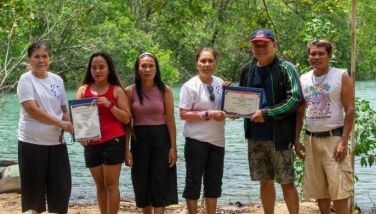Heart attack of the bone
November 16, 2006 | 12:00am
What is a heart attack of the bone? Dr. Robert P. Nirschl coined the term "heart attack of the bone" as synonymous with avascular necrosis. Avascular necrosis is a condition which can occur in people as young as 30 years old and as old as 60. The bone most commonly affected is the thigh bone (femur) and the head of the femur – the ball and socket part of the hip joint. It could happen with an injury, or sometimes it is hereditary or metabolic.
Avascular necrosis is the result of alterations in the blood supply to the femoral head causing it to become "shut out" and to die. This complication can occur in a variety of conditions such as a fracture of the femoral neck or following a dislocation of the hip. The other causes of avascular necrosis of the femoral head cannot so clearly be related to the "shut out" process of the blood supply but can be associated with the use of corticosteroids, systemic lupus errythematosus with or without corticosteroids, renal transplant patients taking corticosteroids or cytotoxic drugs, gout, alcoholism and idiopathic disease (of unknown or obscure causes).
Another concept, which has limited scrutiny, is the experimental evidence of an abnormal number of microcracks (microfractures) in the hip bone due to impairment of bone remodeling which repairs microcracks accompanying the normal usage of the hip. This abnormality occurs when there is an imbalance between the rate of production and repair of microcracks, the former leading the latter – thus microcracks accumulate, causing spontaneous fracture. Such is the case of spontaneous fractures in athletes and March fractures in military recruits.
The other concept, which needs further research, is the impairment of the activation of the osteoprogenitor cell response, which normally causes the repair of microcracks and prevents it from reaching functional significance. This impairment is probably caused by the defective cracks’ detection mechanism by bone cells called osteocytes. It is believed that when a microcrack occurs, the osteocytes tend to distance themselves from the injury, or perhaps the line of microcracks occurs in an area populated by dead osteocytes, and as a result, the microcrack is not repaired and the bone becomes "sick," not "dead." Could there be any abnormalities of bone cell function? Or does avascular necrosis reflect low turnover bone? Is there a dysfunction of bone remodeling? Is this a disease that results from some focal abnormality in the control of bone remodeling? If this overall concept is correct, it should be possible to describe in detail exactly how a robust hip becomes transformed over time into an old and fragile bone, in terms of varying combinations of the balance within remodeling sequences and the frequency of remodeling activation. Understanding the links between the remodeling system and microcracks, and each of the other levels of study, may give us a clue of why one acquires a "heart attack of the bone."
Hip fracture is one of the most puzzling and frustrating orthopedic problems, and it disables many in the most productive part of their lives. It is not known what the true incidence in the Philippines is, but in the United States, estimates as high as 60,000 patients with femoral neck fractures and 20,000 necrotic heads per year have been reported. The percentage of necrosis of the femoral head following fracture of the neck of the femur in the adult is approximately 35 percent. Most people do not know that they have avascular necrosis for sometime until severe incapacitating pain starts suddenly. Such pain is brought on when the blood supply is cut off, or by walking, standing, or moving the affected bone, and relief usually occurs only when one is resting.
Current research shows that there are tiny cracks of the hip that eventually cause the bone to collapse. These tiny cracks are invisible to x-rays, except when seen under a high-power microscope. In my ongoing research on this phenomenon, these microcracks are seen along the subchondral bone, and some emanating from the articular cartilage. Some of them are seen in the trabeculae, a network of bone, inside the marrow cavity, commonly joined together in much the same way as beams of wood are joined together to form a scaffold.
How were these tiny cracks ever discovered? Over 40 years ago, the late Harold M. Frost, M.D., a world-renowned bone expert, my mentor and "boss," discovered that these tiny cracks are seen in the rib of normal people. (Frost, HM: Presence of microcracks in vivo in bone. Henry Ford Hosp. Med. Bull. 8:25-35, 1960). Because it is difficult to show them in x-rays, Dr. Frost and I developed a neat and simple way to make them visible under the microscope. We have used a simple stain or dye dissolved in alcohol (Frost, HM: Staining of Fresh, Undecalcified Thin Bone Sections. Stain Technol 34:135-146, 1959; Villanueva, AR, et al: Staining and Histomorphometry of Microcracks in the Human Femoral Head. Biotechnic & Histochem 69:81-88, 1994). We leave the whole slab of bone suspended in it for 72 hours to a week, then we made ground sections using sandpaper, while running water is dripped gently on the bone to minimize friction and heat. After the bone grinding is over, the thickness of the bone would come to approximately 75 to 100 microns. Since our discovery of these microcracks, which is now accepted by the medical and scientific community, several articles have appeared in the literature. One of them is the author’s research article indicated above.
What is next after we found these tiny cracks in the hip? Information gained from this discovery, I believe, would need further studies, using femoral heads removed following fractures of the femoral neck; arthritic femoral heads removed for replacement; avascular necrosis; ethanol abuse; and osteoporosis. This would be a great research project for a graduate student working for his/her Ph.D., or for a young investigator trying to make something of himself/herself in the field of bone research.
Dr. Antonio R. Villanueva retired from Henry Ford Hospital, Detroit, Michigan, then at Harrington Arthritis Research Center, Phoenix, Arizona. While in both institutions, he was involved in basic research in osteoporosis, bone implant substitutes, and fatigue microfracture studies in the femoral head. He received grants from the National Institute of Health, Henry Ford Foundation, Greenings Foundation, and Sandoz Foundation of Gerontological Research as co-investigator and principal investigator in the study of osteoporosis, bioceramic implants and microfractures. He is also the author and co-author of over 150 peer-reviewed publications and chapters in textbooks of Theory and Practice of Histotechnology and in Handbook of Bone Morphometry.
He also discovered three biological dyes called Villanueva Mineralized Bone Stain and Villanueva Osteochrome Bone Stain now used worldwide, and useful for the evaluation and diagnosis of certain metabolic bone diseases. These stains can be used also for the evaluation and investigation of new bone ingrowth in bioceramics implants. He also developed the Villanueva Blood Stain useful for evaluation of hematologic elements. (All these stains can be seen on the Internet – just type Villanueva Mineralized Bone Stain or Villanueva Osteochrome Bone Stain, or Villanueva Blood Stain).
Dr. Villanueva is a member of various professional organizations. He is also co-recipient of the First Prize Hektoen Gold Medal from the American Medical Association; recipient of the Lab World Achievement Award for outstanding and significant contributions to the world of clinical and laboratory medicine; Distinguished Career Award for outstanding contributions to patient care, medical teaching, and scientific achievement from Henry Ford Medical Association.
Avascular necrosis is the result of alterations in the blood supply to the femoral head causing it to become "shut out" and to die. This complication can occur in a variety of conditions such as a fracture of the femoral neck or following a dislocation of the hip. The other causes of avascular necrosis of the femoral head cannot so clearly be related to the "shut out" process of the blood supply but can be associated with the use of corticosteroids, systemic lupus errythematosus with or without corticosteroids, renal transplant patients taking corticosteroids or cytotoxic drugs, gout, alcoholism and idiopathic disease (of unknown or obscure causes).
Another concept, which has limited scrutiny, is the experimental evidence of an abnormal number of microcracks (microfractures) in the hip bone due to impairment of bone remodeling which repairs microcracks accompanying the normal usage of the hip. This abnormality occurs when there is an imbalance between the rate of production and repair of microcracks, the former leading the latter – thus microcracks accumulate, causing spontaneous fracture. Such is the case of spontaneous fractures in athletes and March fractures in military recruits.
The other concept, which needs further research, is the impairment of the activation of the osteoprogenitor cell response, which normally causes the repair of microcracks and prevents it from reaching functional significance. This impairment is probably caused by the defective cracks’ detection mechanism by bone cells called osteocytes. It is believed that when a microcrack occurs, the osteocytes tend to distance themselves from the injury, or perhaps the line of microcracks occurs in an area populated by dead osteocytes, and as a result, the microcrack is not repaired and the bone becomes "sick," not "dead." Could there be any abnormalities of bone cell function? Or does avascular necrosis reflect low turnover bone? Is there a dysfunction of bone remodeling? Is this a disease that results from some focal abnormality in the control of bone remodeling? If this overall concept is correct, it should be possible to describe in detail exactly how a robust hip becomes transformed over time into an old and fragile bone, in terms of varying combinations of the balance within remodeling sequences and the frequency of remodeling activation. Understanding the links between the remodeling system and microcracks, and each of the other levels of study, may give us a clue of why one acquires a "heart attack of the bone."
Hip fracture is one of the most puzzling and frustrating orthopedic problems, and it disables many in the most productive part of their lives. It is not known what the true incidence in the Philippines is, but in the United States, estimates as high as 60,000 patients with femoral neck fractures and 20,000 necrotic heads per year have been reported. The percentage of necrosis of the femoral head following fracture of the neck of the femur in the adult is approximately 35 percent. Most people do not know that they have avascular necrosis for sometime until severe incapacitating pain starts suddenly. Such pain is brought on when the blood supply is cut off, or by walking, standing, or moving the affected bone, and relief usually occurs only when one is resting.
Current research shows that there are tiny cracks of the hip that eventually cause the bone to collapse. These tiny cracks are invisible to x-rays, except when seen under a high-power microscope. In my ongoing research on this phenomenon, these microcracks are seen along the subchondral bone, and some emanating from the articular cartilage. Some of them are seen in the trabeculae, a network of bone, inside the marrow cavity, commonly joined together in much the same way as beams of wood are joined together to form a scaffold.
How were these tiny cracks ever discovered? Over 40 years ago, the late Harold M. Frost, M.D., a world-renowned bone expert, my mentor and "boss," discovered that these tiny cracks are seen in the rib of normal people. (Frost, HM: Presence of microcracks in vivo in bone. Henry Ford Hosp. Med. Bull. 8:25-35, 1960). Because it is difficult to show them in x-rays, Dr. Frost and I developed a neat and simple way to make them visible under the microscope. We have used a simple stain or dye dissolved in alcohol (Frost, HM: Staining of Fresh, Undecalcified Thin Bone Sections. Stain Technol 34:135-146, 1959; Villanueva, AR, et al: Staining and Histomorphometry of Microcracks in the Human Femoral Head. Biotechnic & Histochem 69:81-88, 1994). We leave the whole slab of bone suspended in it for 72 hours to a week, then we made ground sections using sandpaper, while running water is dripped gently on the bone to minimize friction and heat. After the bone grinding is over, the thickness of the bone would come to approximately 75 to 100 microns. Since our discovery of these microcracks, which is now accepted by the medical and scientific community, several articles have appeared in the literature. One of them is the author’s research article indicated above.
What is next after we found these tiny cracks in the hip? Information gained from this discovery, I believe, would need further studies, using femoral heads removed following fractures of the femoral neck; arthritic femoral heads removed for replacement; avascular necrosis; ethanol abuse; and osteoporosis. This would be a great research project for a graduate student working for his/her Ph.D., or for a young investigator trying to make something of himself/herself in the field of bone research.
He also discovered three biological dyes called Villanueva Mineralized Bone Stain and Villanueva Osteochrome Bone Stain now used worldwide, and useful for the evaluation and diagnosis of certain metabolic bone diseases. These stains can be used also for the evaluation and investigation of new bone ingrowth in bioceramics implants. He also developed the Villanueva Blood Stain useful for evaluation of hematologic elements. (All these stains can be seen on the Internet – just type Villanueva Mineralized Bone Stain or Villanueva Osteochrome Bone Stain, or Villanueva Blood Stain).
Dr. Villanueva is a member of various professional organizations. He is also co-recipient of the First Prize Hektoen Gold Medal from the American Medical Association; recipient of the Lab World Achievement Award for outstanding and significant contributions to the world of clinical and laboratory medicine; Distinguished Career Award for outstanding contributions to patient care, medical teaching, and scientific achievement from Henry Ford Medical Association.
BrandSpace Articles
<
>
- Latest
Latest
Latest
January 10, 2025 - 12:25pm
By Nic Satur Jr. | January 10, 2025 - 12:25pm
December 16, 2024 - 10:38am
December 16, 2024 - 10:38am
December 2, 2024 - 6:19pm
December 2, 2024 - 6:19pm
October 25, 2024 - 9:00am
October 25, 2024 - 9:00am
October 24, 2024 - 11:20am
October 24, 2024 - 11:20am
October 14, 2024 - 11:00am
October 14, 2024 - 11:00am
Recommended

























